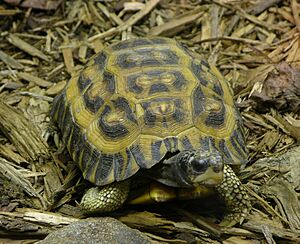Flat-backed spider tortoise facts for kids
Quick facts for kids Flat-backed spider tortoise |
|
|---|---|
 |
|
| At the Philadelphia Zoo | |
| Conservation status | |
| Scientific classification | |
| Genus: |
Pyxis
|
| Species: |
planicauda
|
The flat-tailed tortoise (Pyxis planicauda) is a small tortoise. It is also known as the flat-backed spider tortoise or Madagascan flat-tailed tortoise. These names come from its shell and tail, which are flatter than most other tortoises.
This special tortoise lives only on the west coast of Madagascar. You can find it between the Morondava and Tsiribihina rivers. Because it lives in such a specific area, the flat-tailed tortoise is listed as critically endangered. This means it is very close to disappearing forever.
Contents
What Does the Flat-Tailed Tortoise Look Like?
The flat-tailed tortoise gets its name from its unique look. Its upper shell, called a carapace, and its tail are much flatter than other tortoises.
Shell Colors and Patterns
The carapace has cool patterns. Each part of the shell, called a scute, has a light brown or yellow center. This center is surrounded by a dark brown or black outline. Older tortoises might even have an extra yellow border around this dark outline.
Yellow lines, like sun rays, spread out from the center of each scute. The scutes around the edge of the shell are usually dark. They also have a yellow band around them.
Underside and Body
The lower shell, called the plastron, is usually yellow. It might have some dark spots or lines scattered on it. The tortoise's legs are covered with scales that can be yellow or brown. Its head is usually darker, from dark brown to black, with some yellow marks.
Where Does the Flat-Tailed Tortoise Live?
The flat-tailed tortoise lives in dry forests on the west coast of Madagascar. These forests grow on loose, sandy soil. The tortoises hide among the fallen leaves on the forest floor. They do this when they are not active.
When Are They Active?
These tortoises are only active during the warm, rainy season. This is usually from December to March. They are most active during and right after it rains.
During the cooler, dry season, the flat-tailed tortoise goes into a special sleep. This is like hibernation, but it's called aestivation. The tortoise buries itself and stays dormant until the rainy season returns.
How Do They Have Babies?
Mating usually happens during the hot, rainy season. About a month later, the female tortoise lays her eggs. A female can lay up to three groups of eggs each year. However, each group only has one egg.
The eggs hatch when the rainy season comes back. This is when the young tortoises will be most active.
Why Is the Flat-Tailed Tortoise in Danger?
The flat-tailed tortoise is critically endangered. This is mainly because of where it lives. Its habitat is shrinking fast.
Losing Their Home
One big threat is deforestation. This means forests are being cut down or burned. People clear land for farms, to raise cattle, or for new roads. Mining and oil exploration also destroy their homes. Experts believe that 70% of their forest habitat could be lost between 1963 and 2040.
The Pet Trade
Another danger is people collecting them for the pet trade. Between 2000 and 2002, about 4,000 adult tortoises were taken. This was 20 to 40% of all the adult tortoises.
These tortoises do not have many babies. Females lay only one egg at a time, up to three times a year. This makes it very hard for their numbers to grow back.


